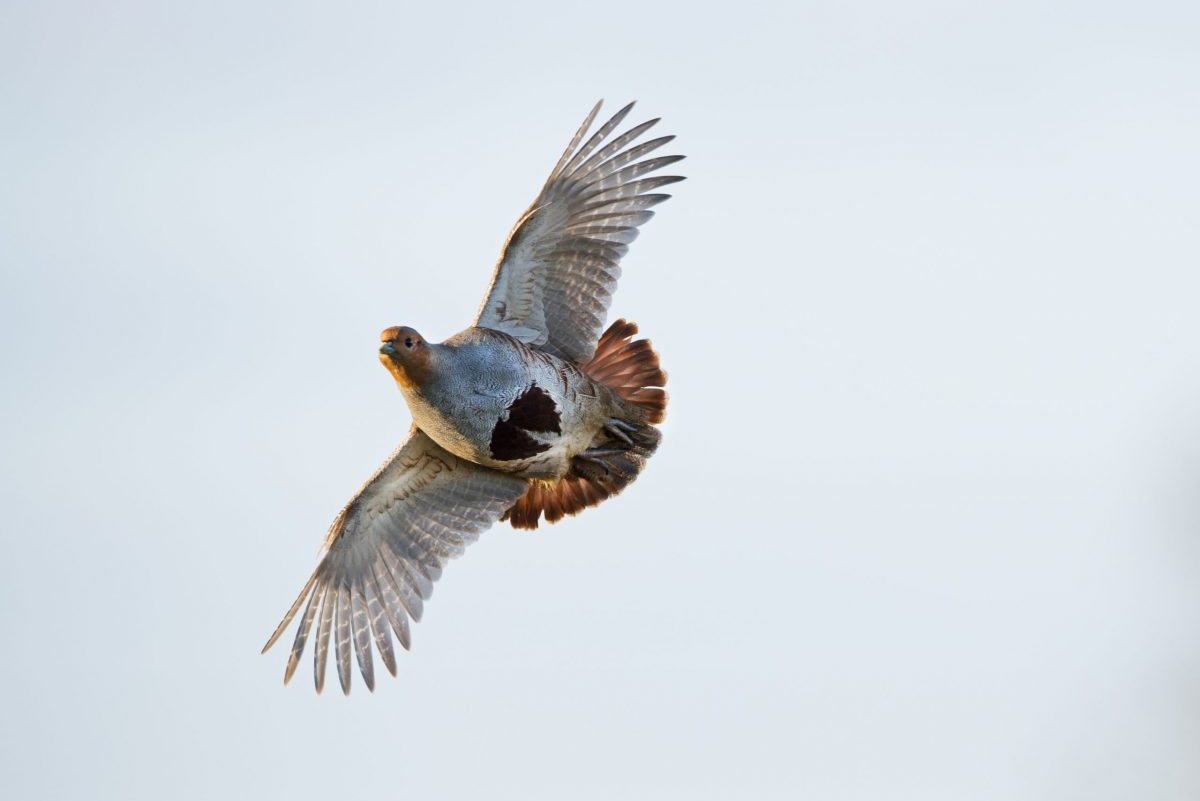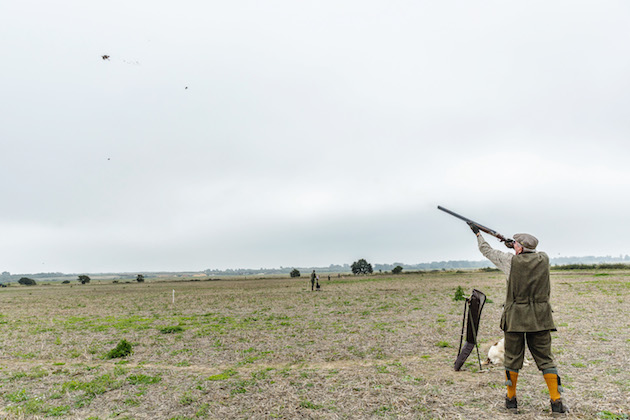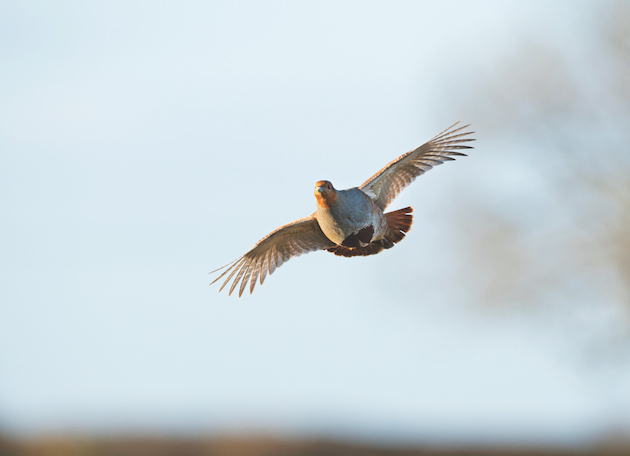The challenges of creating a sustainable population of grey partridges
Creating a sustainable population of grey partridges is a real challenge, and shooting them isn’t much easier, says Richard Negus

The grey partridge is the barometer of lowland conservation success
In less you are one of those lofty types for whom an invitation to shoot at Sandringham, Arundel or Hilborough is the norm, most of us have little need to develop our skills and know-how in shooting driven English partridge. This is due to a fairly straightforward reason. Grey partridges requires a host of very special circumstances in order for drives to be dedicated to shooting them.
The sheer scale of land required, the intricate management in terms of food and habitat and the concerted endeavour of ongoing predator control — all need to combine in order to produce a shootable surplus. Such efforts are Herculean and, to be mercenary, somewhat costly.
Little wonder then, with all of these challenges and the complete reliance upon the weather being favourable during the breeding season, that the majority of shoots today have shunned grey partridges and turned solely to the pheasant and the French partridge as their sporting driven quarry.
Dominate
If you do happen to be one of those scarce beasts who are lucky enough to enjoy a day on the English partridges, I recommend to you the words of the peerless Shot Nick Levett Scrivener. To shoot grey partridges well, he told me, you must “dominate the birds rather than allowing the birds to dominate the Gun. By this, I mean pick a bird early out of a covey — shoot it quick as it’s approaching in front and then move to your second shot, which you should have already preselected.”
While drives of English partridges are — like the bird themselves — rare, this does not mean you will never encounter a covey in a day’s shooting. Although it is generally the norm to hear your host intone on a driven day’s briefing: “No ground game, no woodcock and no English,” there are today an increasing number of shoots, away from the historic partridge manors, where thanks to remarkable dedication and love for the bird, English numbers have recovered sufficiently for them to become sustainable and shootable. Last month I visited one such example in the Dedham Vale.
Ancient
Rivers Hall clings proudly to the Essex side of the River Stour. The Hall knits perfectly into a landscape that folds and rolls around it in a comfortable embrace. Hedges are thick and the woods are ancient, recently cleared of invasive rhododendron and laurel. Water meadows in winter lay wet, a happy home to snipe, while in summer these give lush grazing for cattle. In parts this scene has changed little since John Constable painted here. In the vale it is mixed arable and vegetable land, on the higher ground sheep graze in meadows alongside blocks of wildflower and wild bird seed.

Richard Negus talks to Jonathan Minter, the owner of Rivers Hall
Owner Jonathan Minter is the third generation of his family to oversee the custodianship of the estate, and he is unashamedly a grey partridge addict. Jonathan and his gamekeeper Robert Graves are both previous recipients of Purdey and GWCT East Anglian grey partridge awards — well-deserved winners at that. The fruits of their labours are evidenced not only in the plentiful game, but in the plethora of farmland birds, brown hare and native deer species.
Shooting here is largely for pheasant, although the extensive lake and wilder wetlands add plenty of opportunities for wildfowl to be part of the bag. However, after a concerted effort over the past decade or so, the English partridge is now on the quarry list once more.
I asked Jonathan what he believed constitutes a sustainable number so that greys can be shot.
“We watched them and we counted them,” he replied. “Year upon year numbers rose. Robert added to the wild stock with broods he reared under bantams, which we then fostered to barren pairs. We reached 100 pairs and we seemed to be able to hold that number. Only then did we conclude we could justify shooting a few.”
As a highly regarded Shot by his peers, I quizzed him for advice on how best to shoot these elusive birds. He replied with a smile, an expression he uses readily: “Oh I haven’t shot them for years, but it is lovely to give guests the opportunity.”
Contrary
The first drive of a day at Rivers Hall is an amuse-bouche. Guns are treated to try their hand at the ducks off the lake. Being wild they are contrary; sometimes they flush the wrong way, sometimes not at all. On this day they lofted skywards and carried on lofting. The Guns’ efforts kept the cartridge manufacturers in business but largely unruffled the mallard, teal and gadwall that winged their way up into the clouds.
The second drive, however, was what truly makes Rivers Hall special. The Guns lined out before Robert’s immaculate cottage in the bottom of a valley. Behind them laid a thick, tall hedge. On their right, black as an anvil, towered a hanging wood, on their left a patchwork of fields that runs down to the Stour, still well up after the recent rains. To their front reared a hill, half of which was left to overwintered stubble, the other mown grass filled with desiccated rectangular blocks of wildflower.
Out on the sward, minor ructions were happening. A few brown shapes could be seen scuttling into the shelter of the browning blocks. “Kerr, kerr, kerr,” carried on the scant breeze, leaving no one in any doubt as to what those tan forms were.
Way up on the hilltop, the tapping of beaters could be heard and a pop or two from walking Guns as pheasants flushed back. Woodcock blobbed out of the wood on the brow. Two fell in two shots; migrants have been flocking into the estate in incredible numbers over successive full moons.

The secret to modern English partridge shooting is the ability to be sparing — simply watching these birds is part of the magic
A trio of flankers appeared to the right, mirrored by flag-bearers on the left, funnelling birds. In his customary unhurried manner, Robert marshalled the back line of beaters, meeting the flankers to form a rectangle. Up sprung a covey of greys. They swept down, hugging the ground a mere 10ft or so above the crisp seed heads of oxeye daisy and campion with what appeared to be a leisurely insouciance. However, greys are deceptive things.
One hundred yards before the Guns they rose up at speed, tilting their wings to top the hedge. With the Guns’ outline masked by this backdrop, the wary birds discovered their error at the very last moment. Out of a covey of eight, one presented itself as a shot. With exemplary skill and sportsmanship, Simon Golding bowled over the cock bird then ported his barrels to watch the rest burst by.
This is the true secret to modern English partridge shooting. While good technique remains of utmost importance — the footwork, the domination, the speed of reaction — it is the ability to be sparing, to only shoot what gives you pleasure, to know when not to shoot and merely watch and marvel at these magnificent birds.
Grey partridges are the barometer of lowland conservation success and they should be treated in the manner the denizens of Rivers Hall do — with marked reverence.








